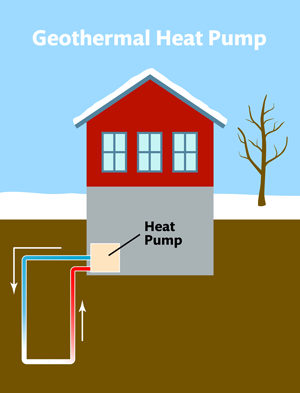Geothermal Systems
Geothermal systems (also called ground source, or geothermal, heat pumps) take advantage of the constant temperature of the ground below the frost line to heat in the winter and cool in the summer. Like all heat pump technologies, geothermal systems don’t create heat, they move it using the same process as air conditioners and refrigerators. In the winter, heat is drawn from underground and is transferred to the house. In the summer, the process is reversed to remove heat from the house and transfer it to the ground.

- Fluid is pumped down into the ground, where it warms to ground temperature.
- A heat pump extracts the heat from the fluid and delivers it into the home.
- The now-cool fluid is returned to the ground to start the process over again.
Source: EPA
This reversible refrigeration cycle process is one of the most efficient ways of heating and cooling your home. Geothermal heat pumps are typically more efficient than air source heat pumps because the temperature of the ground is moderate and closer to the desired indoor temperature year round than outdoor air temperatures. One unit of electricity can translate into four or more units of heat with a geothermal heat pump. Like air source heat pumps, geothermal systems are good at keeping indoor temperatures and humidity levels constant.
Geothermal systems consist of a ground loop and a heat pump. Loops can be in a shallow field or in deep wells. Heat from the loop is extracted by the heat pump, which is typically located in the basement. Heat is then distributed through the home via radiators, a radiant floor or a forced hot air distribution system.
Advantages
- Lower heating and cooling costs — Geothermal systems typically cost less to operate than other systems. Click here to compare operating costs of different heating systems.
- Indoor comfort — Geothermal systems provide consistent indoor temperature and humidity levels.
- Safety — Because geothermal systems are electrically powered, there is no risk of fuel or combustion gas leaks.
Disadvantages
- Installation costs — Geothermal systems are frequently more expensive to install than conventional heating or cooling systems.
- Installation challenges — Not all buildings or yards are good candidates for geothermal systems. A siting assessment can determine if a location is suitable for a geothermal system.
